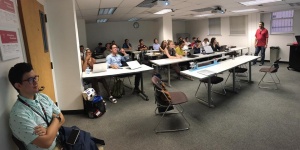On Monday, August 21, 2017, nearly all of North America got a rare treat to observe a full solar eclipse as it passed from Oregon to South Carolina. Most people I know stayed in the Los Angeles area and observed the partial eclipse (almost 70%) while at work. Others took the day off and flocked up to Oregon to contend with the crowds. I took the opportunity to return to the Midwest to see my family and witness the full eclipse from the southeast corner of Nebraska as the eclipse made its path there just after 1 pm.
Was it worth dodging scattered thunderstorms throughout the state and driving 5 hours with very low odds on having clear skies? Yes!
Fortune smiled on us as the clouds cleared (for the most part) at just the right moment. While many locations were destined to be disappointed by heavy cloud cover and rain, the city of Beatrice in Nebraska was blessed to have a clear enough view through thin high altitude clouds. A view clear enough for me to snap a few pictures using the solar eclipse glasses as a lens cover with my cell phone as the moon moved into totality.
Only during the moment of complete coverage (totality) was it safe to directly view the sun. Even under a partial eclipse, the sun WILL damage your eyes if viewed directly. To be safe, only eye-wear and filters that meets the ISO 12312-2:2015 specification requirements should be used.
While my photos of the corona were underwhelming, I did snap some photos around the area to show how rapidly the skies got a little dim and then DARK! To illustrate what it was like in the path of totality, In these four successive shots of the same street view where we stood, you see just how dark it suddenly gets in the penumbra. Our location was nearly ideal as we had nearly 2 minutes and 30 seconds under the total solar eclipse!
I was glad to witness the event with my wife, Kathleen, and my nephew, Joseph. It’s these rare events that can make great memories as you do them with family and friends.
If you missed this grand event, Americans will have another chance almost seven years later on April 8, 2024. The NASA website is an excellent resource for eclipse viewing and future events.
NASA official website – Eclipse
If anyone else has photos or stories to share, please let me know on the forum.
secretary@rrs.org












